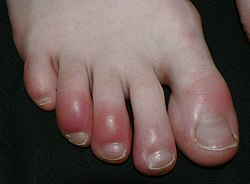Inflammation
![]()
Calor is a redirect to this article. For the Dutch producer and DJ, see Julian Calor.
![]()
This article explains the medical term; for the initiation of combustion (chemistry), see there.
Inflammation is the body's reaction to harmful stimuli, which is classically expressed by the inflammatory signs of redness, swelling, hyperthermia, pain and functional impairment. Messenger substances of the immune system cause a dilation of the blood vessels, so that the area of inflammation is supplied with more blood; in addition, the vessels become more permeable for the escape of blood plasma and immune cells into the tissue. According to a broader understanding of the term, all immune reactions occurring at specific sites are referred to as inflammation. The technical terms for inflammation are formed by adding the suffix -itis to the Greek name of the affected anatomical structure.
Inflammation can ensure the integrity of the organism by, for example, removing pathogens or foreign substances from the tissue. Haemostasis and coagulation, inflammation, clearance of cellular debris and wound healing are closely intertwined processes that sometimes run side by side. Inflammation, which does more harm than good to the individual, is of great medical importance and a frequent target of anti-inflammatory treatments.

hypothermia
Properties
A foreign substance, antigen or tissue damage triggers the stimulus for a defensive reaction of the immune system. The inflammatory reaction takes place in the affected organ, in the surrounding connective tissue, in the blood vessels involved and in the adjacent lymphatic system. This leads to the typical signs of inflammation: redness (lat. rubor), hyperthermia (lat. calor), swelling (lat. tumor), pain (lat. dolor) and impaired function (lat. functio laesa). These five signs, of which the first four were already described by Celsus and the fifth was added by Galen, are not always directly recognizable or even partially detectable. An inflammation of the mucous membrane of the stomach, for example, may cause pain chiefly after eating, and is then symptomatic only for a limited time. It may be accompanied by nausea.
The redness and swelling occurs due to the increase in the permeability of the blood vessels in the course of diapedesis of immune cells, erythrocytes and plasma proteins through the release of the messenger substances interleukin-1 and prostaglandin I2. The migrated cells and plasma proteins are called infiltrate. Pain is caused by the release of pain messengers (prostaglandin E2, prostaglandin I2, bradykinin and other kinins) and cytokines (tumor necrosis factor) by the immune cells and serves to immobilize the affected body part and conserve energy reserves by reducing activity. The increase in temperature is mediated by cytokines such as interleukin-6 via the production of prostaglandin E2 and results from increased metabolic activity.
Often the reaction consists of rejection of part of the diseased tissue by necrosis or apoptosis followed by the formation of new cells to repair the tissue damage. In the case of skin cells, one of the purposes of cell rejection is to protect the underlying tissue. Inflammation can be localized to a (small) circumscribed area or can affect the entire body. Examples of localized inflammation include enteritis (inflammation of the intestine), colitis (inflammation of the colon), gastritis (inflammation of the stomach), arthritis (inflammation of the joints), myocarditis (inflammation of the heart muscle), dermatitis (inflammation of the skin), and otitis (inflammation of the ears). A linguistic exception is pneumonia (inflammation of the lungs), in which the ending "-itis" is missing (however, the form pneumonitis is also rarely used).
In classical medicine, inflammations are often combated by stopping the triggering stimulus. If the defensive reaction is suppressed within the framework of symptomatic therapy, healing can be delayed.
Causes
Any stimulus exceeding the physiological level can trigger inflammation. This applies in particular to physical stimuli, such as mechanical stimuli (e.g. pressure, friction, injury or foreign bodies, e.g. metabolic products such as uric acid crystals), thermal stimuli (e.g. heat, cold), radiation (UV, infrared, ionising radiation), chemical stimuli (irritating and harmful substances such as acids, alkalis, toxins, derailed enzymes, e.g. in acute pancreatitis). acids, alkalis, toxins, derailed enzymes, e.g. in acute pancreatitis), allergens and autoallergens (e.g. in rheumatic or autoimmune diseases) or pathogens (bacteria, viruses, fungi, parasites).
Search within the encyclopedia